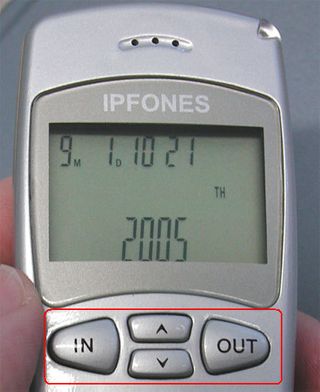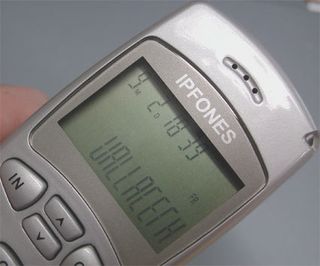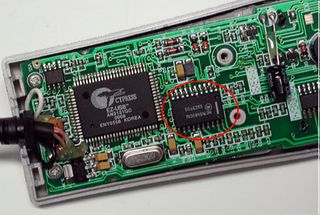Connecting With Skype's Phone Service
Totally Easy To Use, But It Could Use A Better Display
The IP-700m USB World Phone's unique and redeeming ability is its ability to enable Skype access through its keypad. In other words, you don't have to use the PC keyboard to invoke Skype - rather, you need press only a button on the handset to bring up the Skype window on screen.

Using four buttons (red rectangle), you can use the handset to navigate the Skype interface
Using both buttons labeled "In" and "Out" you can switch among the Contacts, Dialing, and Recent calls sub-menus. The arrow keys permit selection of a contact to call. Once any number is selected, simply press the green button to dial it. To end any call, simply press the red button. Those with SkypeOut accounts can also use the keypad to dial out-of-network users on hard lines or mobile phones as well.
The liquid crystal (LC) display could be improved, however. Because it lacks backlighting it's either impossible or difficult to see in dark or dimly light environments. For incoming calls the display shows the Skype name of the caller (where applicable). But because of restricted display capabilities on the viewing screen, the seven-segment displays used to show characters aren't always clear or completely readable. For example, a Skype name like WALLACETX looks like UALLACETH on the display.

Who's UALLACETH?
For outgoing calls, the mini-screen shows only the numbers entered into the device, but not the Skype names for contacts selected from the contact list.
Under The Hood: Great Sound Thanks To PCM Codec/filter
Naturally, we popped open the case to take a look at the IP-700m USB's inner workings. The main electronic components we found included the Cypress AN2131QC and the Motorola MC145480.
Stay on the Cutting Edge
Join the experts who read Tom's Hardware for the inside track on enthusiast PC tech news — and have for over 25 years. We'll send breaking news and in-depth reviews of CPUs, GPUs, AI, maker hardware and more straight to your inbox.

Cypress provides the USB interface, voice capabilities come courtesy of the Motorola PCM codec.
Whereas the ANC2131QC handles the USB interface for this device, the MC145480 manages the encoding and decoding of speech (and other sounds). As a so-called PCM codec/filter, in fact, the Motorola chip not only handles encoding and decoding, it also digitizes and reconstructs human voices, and even concerns itself with important things like noise reduction and cancellation. While it's important to deliver speech with maximum fidelity, the same is not true for background noise picked up as it's captured and delivered to its recipient.
IPFones describes its (successful) efforts at delivering the best-possible voice quality with the marketing phrase "Digital Clarity Sound".
Current page: Totally Easy To Use, But It Could Use A Better Display
Prev Page Installation, Continued Next Page Practical IPFones Test And PerceptionsMost Popular

